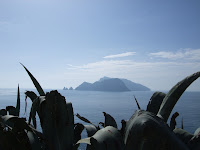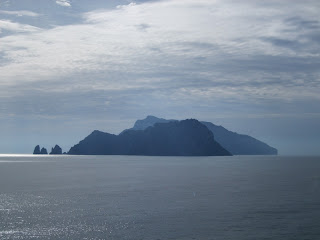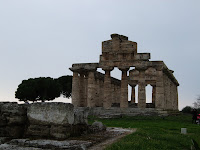written 22nd March
Arriving just after dark, in a never-ending queue of rush hour traffic, Sorrento did not, at first, appear to be very van friendly so we pressed on the Massa Lorense, which didn't seem much better. However, a quest for petrol and an attempt at finding an aire, took us back to Sorrento where we found one but not the other, and quite by chance, the only unmetered parking bays in town. Brilliant.
And the next morning the sun was shining as we set off into tourist city in search of coffee and a bun for breakfast. even better
As the biggest and most well known of the towns on the northern side of the peninsular which bears its name, Sorrento is a tourist town and proud of it. Built right to the edge of the sheer cliffs which jut out into the bay of Naples, as well as being a destination in its own right, it is also a jump off point for the beautiful Amalfi coast and jet set Capri. And in the brightly shining saturday morning sunshine it was rather lovely.
We wandered into town, past the horrifically expensive cafes in the main square and into the typical streets. We were just despairing of finding coffee anywhere for less than €2 a cup, let alone a bun, when Will spotted a barely signed, dark doorway with a throng of chattering locals where €3.50 got us coffee and delicious buns - so tourist tax is 150%!
We wandered to the Marina Piccolo
and whiled away some time watching the dinky cars pootle round below us, in particular the logistical shuffling of the long-stay managed parking and the random swerve and stop manoeuvre which constituted parking outside the carpark - much less dull than it sounds honestly!
Back into town and a further stroll took us to the Marina Grande through the typical streets where we found tourist tat of all types, including:
Talking teatowels ("look at me!"),
Curiously shaped hanging cheeses (we later found, by buying some in a supermarket, that is it so you can smoke it - yummy)
Brightly coloured tourist pasta, including some of unmentionable shapes - look very closely...

The biggest lemons I have ever seen
As well as lemon soaps, lemon liqueurs, lemon sweets, lemon ceramics and anything else you can possibly imagine you can do with either a lemon or an image of a lemon
And most disturbing of all, holographic dying Jesus pictures where not only did the eyes follow you as you walked past, they also opened and closed (or winked if you stood in the right place) - just too creepy!
Having had our fill of tourist tat - lovely though it was - and deciding against a trip to Capri - would have to leave Jules behind even though it was very, very tempting to see just what the parking attendant guys would make of it... - we headed on up and out. Heading away from the usual tourist trail straight over the top to Positano, we headed back through Massa and after several sweeping curves and little villages, ended up at Termini where we spotted a sign for a Punto Panoramico - sounded just perfect for a late lunch stop. No real carpark and a suddenly narrowing road led to a 16 point turn in the road using forward and reverse gears and a nose-in-the-cliff swerve and stop parking approach (like all the other local cars!) where we left Jules, in gear, with the handbrake on and a wheel choc or two - it was that sort of road - and headed off.
The path was glorious, at first winding along the contours of the olive terraces, then sweeping down towards the sea,
with Capri always to the right of us floating in the blue haze. It was perfectly sunny and still, with the only sounds being our footsteps on the path, the gentle swich of the sea, the chirriping crickets and occasional bird song, and the busy buzz of rustic chainsaws - it apparently being olive prusning season. bliss
We eventually found the 'point' and had our picnic in the gloriously warm sunshine before heading back up and off again.
Next stop planned was Positano, the start of the famous Amalfi coast drive, likened to heaven by all sorts of eminent literary figures.
Sadly, initial appreciation of the road was marred by once again running out of petrol, like seriously, off the bottom of the gague on a hilly, single carriageway coast road with hairpin corners and not enough stopping places, where the towns cling to the side of the near vertical cliff and entry into them in a van, no matter how little, just does not seem like it will end well... Our problem is caused by the shocking price of petrol here - the most expensive of the trip so far and we thought south of france was bad - and the seeming complete lack of price sensitivity here - again even worse than in France or Spain. This means that you can see petrol at €1.449 in one place then 500 metres down the road at €1.389 and there will still be people at the first place filling up. Just wouldn't happen in the UK. We have even seen petrol stations of the same chain, on opposite sides of the road with different prices, and again, as many people in the expensive side as the cheap side. Just unfathomable. Makes a differnece of a 50l tank too! What this means therefore, is that we are always looking at petrol prices, just to get a feel for what is the average and spread in a locality and if it is expensive but we have no choice, we just put €10 in at a time. This also means we are on the verge of running out a lot.
We have also learnt that, whereas in france, if you ask someone how far away something is, the answer is always '5mins away', regardless of actual distance, prevailing traffic conditions or actual likely time it will take to drive there (as all their Carrefour adverts have a time in minutes on them, we have studied this phenomena, actual time can be anything from a factor of 2-5 times quoted time), if you ask in Italy, the answer is always 2km. Space and time in europe are clearly somewhat more elastic than we are used to. We have come to the conclusion that it just means 'too far to walk'.
But somehow Jules just keeps going and after a tense 20 mins of so, with Will coasting at every available opportunity - which scares me as it seems all the time like the engine is just cutting out and all is lost! - we did find the place the wizened little old man had indicated. €1.468!!! the price for entry to heaven is steep :)
So back to Positano, past bars full of football watching folk and even one car, with about 6 people crammed into it, parked in a layby at the foot of a cliff with a TV on the dashboard and one man outside holding up the arial - I guess there are somethings which are more important in life than even the most beautiful views! - and a cliffside stop behind a big truck just far enough of the road to be sure the wing mirrors would last the night and off into town as the sun set.
Positano is one of the most fashionable towns on the southern side of the peninsula and is apparently where rich people come to shop in chic boutiques.
Most of the tourists had left for the day so it was all rather nice, as we strolled, hand in hand, through the warm, softly lit streets, through plazas bedecked with strings of lights, and up narrow winding alleyways of cobbled steps, all the while gazing into the brightly lit windows full of more lemon tat, decorative cakes and icecreams made of china or candles,

the most floral of floral printed dresses - not sure wheher is is supposed to be fashion or camoflauge and if the latter, quite which tropical jungle you would be good for...
- and the occasional 'real' alimentari off the more beaten paths. just lovely.
Sun still shining the next morning as we set off along the coast road,
which was every bit as lovely as anticipated, with glorious new vistas at every turn.
Through Priano, Furore and Amalfi - all not very van friendly looking -
and up into the sky to Ravello, apparently closer to heaven than to earth, and inspiration for writers and composers alike (apparently DH Lawrence wrote some of Lady Chatterly's Lover here and some garden in Wagner's Parsifal was based on his villa here)
for a coffee and a view.
Then a stop on the side of the cliff for lunch - lovely.
Feeling we had had the best of the coast drive, the typical cliff side streets and the weather for the day, we headed onwards once more in search of ruins, older, greek ones this time, in Pasteum.
The draw of Pasteum is the magnificent greek temples which still stand amongst the ruins of a town which was first greek and later roman. It is in our 1001 places book and more importantly, the Rough Guide says the ruins are 'the best preserved Doric temples in Europe' and the museum is 'splendid'. Some choice gems from it recently have been:
Grotto della Smeraldo: 'a mildly impressive but certainly not unmissable sight'
and
Salerno: 'the site of the Allied landings of September, 9th 1943, that reduced much of the city centre to rubble. The subsequent rebuilding has restored neither charm of efficiency to the town centre'
so you see 'splendid' is high praise indeed!
The Piana del Sele is a large flat expanse of largely marshland stretching from the inland hills to the sea. Over the millenia, the coastline has advanced and receeded with the thaw and freeze of the ice ages and the plains have been inhabited since man first picked up a rock with any clear intention or purpose in his tiny mind.
When the Greeks arrived in the 7th century BC, they kicked out the Etruscans and established themselves on a terrace of travertine, overlooking the coast and built a city they called Poisedonia, in honour of the God of the Sea.
During the 200 years of so they were there, they built a considerable fortress and three magnificent Doric Temples. The extent of their wealth and success attracted jealousy and the town was taken by the Lucans, an italic tribe (history does not relate as to whether they were all a bit slanty...) who routed the Greeks in 400BC and changed the name of the place to Paistom but that wasn't to last as when the mightly Roman Empire turned its attention south, they too were attracted by the well established position and defeated the Lucans in 273BC and established a latin colony there called Pasteum, which was later to become an important source of assistance during the war with Hannibal.
They quickly covered over, filled in or destryoed most of the important greek public buildings but left the three temples standing, and built their own infrastructure including the forum, amphitheatre, baths and everything else we have come to expect from a Roman town. However, its fortunes were only short-lived and by the latter years of the empire, most of the inhabitants had fled the malaria-ridden marshland which was being targeted by the Saracens, and ran for the hills and the town was eventually abandoned completely.
And thus it stayed until the advent of the Grand Touring northern europeans to the area in the early 18th century, who rediscovered the temples, still standing amidst the overgrown woodland and it was apparently their discovery of the place which led to the influence of the Doric style in neo-classical architecture throughout europe.
What is almost more amazing however, than the fact that the temples are still standing, is one of the later yet much older (paleolithic or neolithic, one of the -lithics anyway!, possibly early bronze age, can't remember) findings nearby at the Necropolis of Gaudo. When the Allies landed in 1943, the americans and british divided up the coastline for their separate landings. The British were busy building a runway, under sporadic german sniper fire from small pockets of resistance in the hills, when they discovered a burial chamber and the remains of various people and pottery items. Instead of thinking, 'well here's a war on chaps, got to get on with the job in hand' they stopped what they were doing and sent for a proper archologist type who ensured that, in the midst of the invasion chaos, the tombs were excavated and documented in accordance with the British Museum's exacting standards - something, apparently, they didn't believe the Italians would do. They found a treasure trove of pre-history stuff and went on to establish their field hospital in the ruins of the three temples - it is utterly amazing that any of it survived at all.
Arriving late sunday, after a drive down a just off-the-coast road once more lined with hookers hoping for some passing sunday afternoon trade - just loads of them! - we found we could see the temples really well from the road and that the rest of the ruins were very ruinous indeed. So we skipped that and, having had our fill of the view, settled down on the beach for the night with the sun setting on another day.
The next morning, the museum was indeed splendid. It covered the prehistory and geography of the area from the second-to-last iceage onwards and all the -lithic peoples with info panels, videos (the only hairy cave man with a beerbelly I have ever seen!) and case after case of 'finds' which just leave you in awe at what they achieved and crafted out of so little, from stone, to flint, to copper to bronze.
Head spinning after all that and no cafe for a break which was a shame as we probably didn't appreciate the greek stuff (what we'd actually come for!) as much as we might have done but again, the things they created, especially the decorated pottery and statues were simply stunning in their intricacy.
The most famous thing there is the Divers tomb, a stone sarcophagus decorated on the inside with greek images of knowledge sharing in the syposium (the men on couches drinking wine) on the sides and the diver on the inside of the top, reperesenting man's departure from the bounds of the known world and into a sea of greater knowledge which is death. Apparently this is the only Greek tomb found decorated on the inside like this, something etruscans had been doing for ages, an is particularly out of kilter with fashionable thought a the time which would never link the disparate images of life and death in this way. So there you go.
It seems the Lucans did decorate their tombs in a similar way, with lots of roman-esque looking images.

And then upstairs to the roman room, coins, statues, carvings, really, really need coffee now...
There was also a display which seemed to be proposals for redevelopment of the surrounding ares, which look hideous. If you want to come, come now!

I have also decided that I don't know enough about Greek or Roman Gods and mythology so have down loaded the Iliad to read - well you've got to start somewhere...
So, this is the most southerly point on this incursion into Italy and we didn't really think to be getting this far by this time. We are meeting friends for an Italian Lakes break next week and still have to go back to rome so it is time to head back to the frozen north (although it is looking more promising now!
So Carrefour detour - the first one we have actually seen in Italy and we are intrigued as to what carrefour.it will be like - then back to rome by way of St Felice Cicero - well the police have told us where to park now so we should be assured of a quiet night's sleep and no rude awakening at some ungodly hour....








































Great pictures and descriptions as usual - I can feel the warming sun from here......well I can't actually as the 'riviera' is a dull, damp, drizzly 10 degrees.
ReplyDeleteWhat AM I doing still here?
Pic missing off previous blog entry - did you overload the system!
B&B